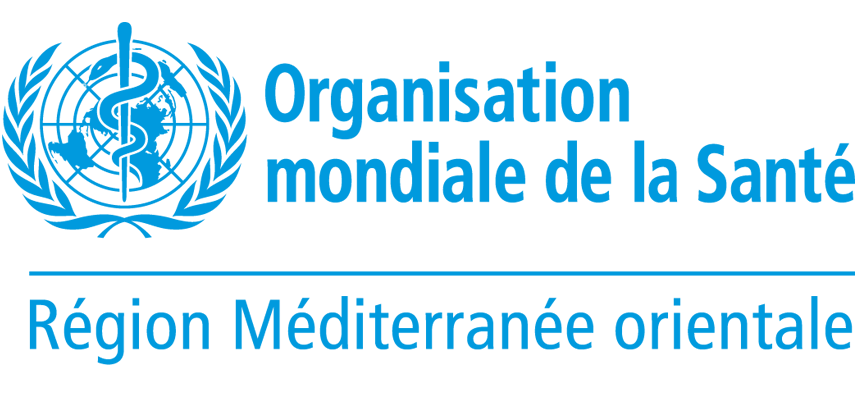WHO continues to support and invest in community-based surveillance system for COVID-19 and epidemic-prone diseases with USAID support
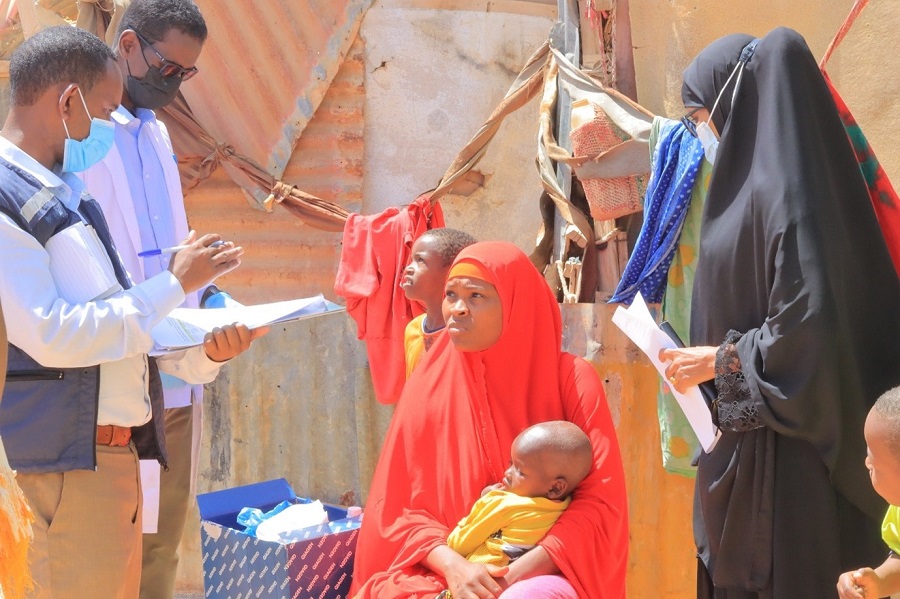
WHO-supported community health workers help connect communities with nearby health facilities to win hearts and minds of locals. Credit: WHO/Somalia
Mogadishu, 15 April 2023 – The World Health Organization (WHO) Somalia with the timely support of United Stated Agency for International Development (USAID) is helping the Ministry of Health to strengthen and expand the community-based surveillance system in underserved areas, which is essentially addressing the health system gaps and bridging a vital clog between these communities and health system.
Community health workers are being effectively used in crisis affected countries to bridge the health system gaps for surveillance when there is an acute shortage of health care workers. Learning from its successful intervention to control the community spread of COVID-19 in Somalia, WHO country office has supported the Federal Ministry of Health to deploy over 2100 community health workers (CHWs) and 237 rapid response teams (RRTs) across Somalia. With funding support from USAID, these CHWs and RRTs form the backbone of the community-based surveillance system which has been established last year to support the facility-based surveillance system of EWARN in the country for rapid detection, identification and reporting of COVID-19 cases, including other epidemic-prone diseases in the communities living in underserved and hard-to-reach areas.
“This COVID-19 plus effort by WHO is resulting in multiple benefits ranging from confidence building measures between the government and the communities, as well as in restoring our fragile health system. There, surely, was no other way to achieve these 2 milestones and I am sure that donors like USAID will continue to help us sustain such game-changing efforts,” said Dr Mukhtar Abdi Shube, National EPI Manager for Federal Ministry of Health.
These WHO-supported community health workers, almost half of whom are women, report through a mobile phone-based application for community-based surveillance. This network of CHWs was primarily established during COVID-19 pandemic to raise alerts and awareness using risk communication and community engagement activities.
However, due to prolonged drought, which has already impacted over 8.25 million people and displaced over 3.5 million across the country, WHO Somalia has helped the COVID-19 focused community-based surveillance system to graduate to a new level by including 12 epidemic prone diseases and events. After consultation with Health Cluster partners and the Federal Ministry of Health, WHO held a series of capacity-building workshops to help the existing workforce of CHWs to learn the basics of reporting on 12 prioritized diseases including COVID-19, cholera, measles, malaria, tuberculosis (TB), HIV using a syndromic-based case definition.
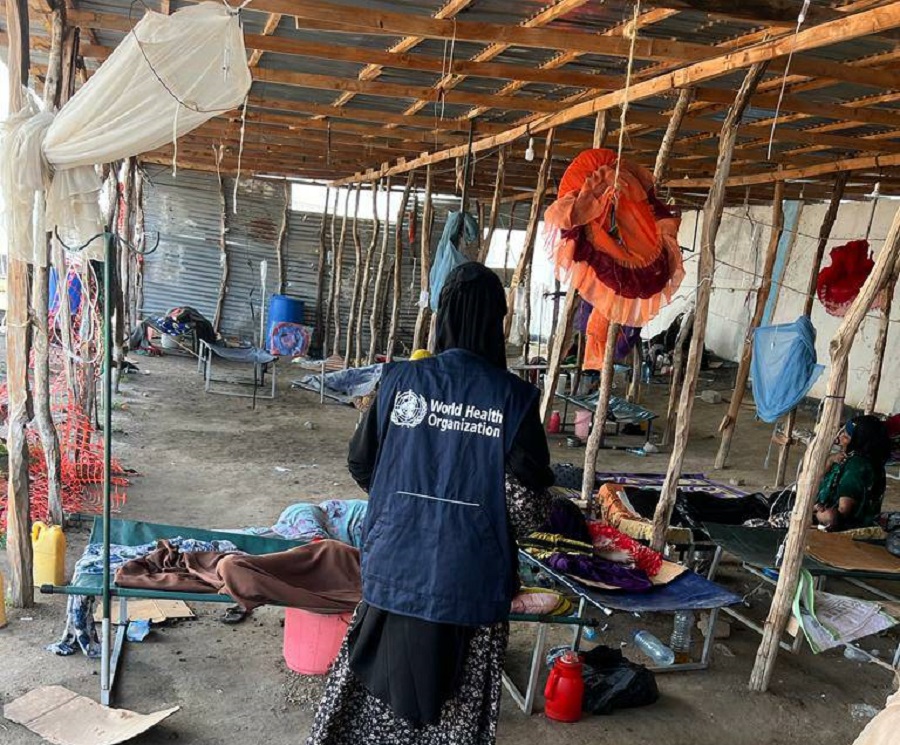 A WHO-supported cholera treatment centre in the border areas of Lower Juba region is treating patients referred by the community health workers from the neighbouring districts. Credit: WHO/Somalia
A WHO-supported cholera treatment centre in the border areas of Lower Juba region is treating patients referred by the community health workers from the neighbouring districts. Credit: WHO/Somalia
“WHO has helped us to rediscover the broken health system in Somalia by supporting us to train and deploy these front-line health workers across the country. These locally hired community health workers and vaccinators have literally helped us get in touch with the communities and for the first time we are realizing the depth and scale of the public health issues confronted by the communities,” commented Dr Bashir Ahmed, District Public Health Officer managing the cholera treatment centre in district Afmadow in Lower Juba region.
A positive by-product of this network is that it has become a functional linkage between the communities and the health system as these community health workers are referring severely malnourished children to one of 64 WHO-supported stabilization centres, serious cholera patients to one of 10 WHO-supported cholera treatment centres, pregnant women to nearby reproductive, maternal, neonatal, child and adolescent health centres or helping midwives to facilitate home-based deliveries and promoting routine immunization, as well as vaccinating zero dose children.
WHO Representative to Somalia, Dr Mamunur Rahman Malik, believes that, “These community health workers are a means to an end. They are serving as a kingpin to revive the confidence of communities in the health system, as well as helping the federal and state ministries of health to get a hand on the pulse of communities, understand their real health needs, and rapidly becoming a vital clog between the underserved communities and the fragile health system in the country.”
Community health workers across African settings have been known for extending health services at community level particularly in underserved or remote populations. The community health workers in Somalia and other humanitarian crisis-affected countries are also filling the acute human resource gaps and deliver public health services directly to underserved communities as part of outbreak and pandemic response for preventing infections and reducing spread. By virtue of their understanding of the local context in the community and trust they garner from the people they serve, the community health workers are increasingly becoming useful and effective for the response to COVID-19 and other epidemic-prone diseases.
This community-based network of health workers and rapid response teams has given the confidence to the Government to replicate it in the newly liberated areas across Somalia. In the past one year alone, these WHO-supported community health workers have visited a total of 2 029 611 households with the preventive health messaging. A total of 20 909 alerts were reported by these CHWs of which 10 174 were investigated. They screened 328 519 children for malnutrition, of whom 97 786 were referred to health facilities for necessary treatment while another 19 807 children were also referred to these health facilities due to severe respiratory issues and/or dehydration. They also provided iron and folic acid supplements to 95 524 pregnant women, while zinc and vitamin A supplements to over 145 491 children.
How the CHW network works in Somalia
WHO Somalia, together with the Federal Ministry of Health and other UN agencies, conceived an integrated health response to the drought and COVID-19 pandemic by improving access to essential health care across 48 priority districts in the country. WHO deployed these community health workers as part of this initiative to increase access to essential health care for the communities living in marginalized and underserved areas of these 48 districts.
Now, these community health workers are being trained on case detection for epidemic prone diseases beyond COVID-19, provide home-based care for children with diarrhoea, malaria, TB, HIV, and other ailments, and identify danger signs, especially among children and women, and refer them to the nearest health facility.
Since they were locally recruited and enjoyed the trust of the locals, they were also trained on delivering a range of culturally appropriate risk communication and community engagement messages on healthy living, water, sanitation and hygiene (WASH), nutrition and infant and young child feeding during house-to-house visits besides helping the state-based health authorities detect epidemics as early as possible and reduce the turnaround time for response.
To compliment the work of community health workers, WHO Somalia has also established an oversight and mentoring mechanism by deploying district-based rapid response teams. From an initial deployment of 171 teams, WHO increased the numbers to 237 teams during the pandemic. These rapid response teams include a surveillance officer, a laboratory technician, and a social mobilization officer from the districts. These teams serve to verify alerts reported by CHWs and investigate credible alerts with sample collection. RRTs are also responsible for providing supportive supervision to health facilities through the Early Warning Alert and Response Network (EWARN) system and monitor the activities of the CHWs at the household level and at various points of entry.
To meet the increased demand of the health services, WHO is maintaining the operational response capacities of 281 health facilities across the country by supporting these facilities with 64 stabilization centres, 10 cholera treatment centres, 15 oral rehydration points in Somalia. These health facilities are being supported with the provision of essential medical supplies like interagency emergency health kits, trauma kits, cholera kits, severe and acute malnutrition kits to treat children with health complications, and oxygen concentrators.
==============================
Note to editors
Since December 2021, Somalia has been experiencing an escalating drought that has affected 8.25 million people and displaced over 3.25 million people in search of humanitarian assistance. Over 6.4 million people (38% of the total population) do not have access to safe water and proper sanitation. The situation is worsened by protracted conflicts and the COVID-19 pandemic that has led to further weakening of an already under-resourced and under-staffed health system leading to a higher proportion of people with limited access to primary health care services.
At-risk ‘zero dose children’ get vaccines as Somalia drought woes mount
As drought stretches into a sixth season, WHO outreach teams target unvaccinated children reaching displacement camps where measles and pneumonia are rife.
3 April 2023 – Baidoa, Somalia – Somali farmer Fadumo Mohamed Ibrahim’s crops failed in the drought and she set out on foot for help.
Twenty-five days later, she and her daughter Khaliye stumbled into a settlement in the outskirts of Baidoa, a city in central Somalia, sick and exhausted.
“There is no health care in my village, my children have never been vaccinated,” the 30-year-old says.
 Fadumo Mohamed and her daughter Khaliye pictured at Raama Cadey camp for internally displaced people in Baidoa, Somalia, 22 March 2023. Khaliye, who has never received a vaccine, was vaccinated against measles, polio and pneumonia by an outreach team supported by WHO. Credit: Abdulkadir Zubeyr
Fadumo Mohamed and her daughter Khaliye pictured at Raama Cadey camp for internally displaced people in Baidoa, Somalia, 22 March 2023. Khaliye, who has never received a vaccine, was vaccinated against measles, polio and pneumonia by an outreach team supported by WHO. Credit: Abdulkadir Zubeyr
Arriving at the crowded settlement of fragile plastic-roofed shelters, the camp leader and health outreach workers took her to a vaccination team in an early step to safeguard their health.
“We were told by householders to get a vaccine. They told us it was important,” she adds.
 Fadumo Mohamed pictured at Raama Cadey camp for internally displaced people in Baidoa, Somalia, 22 March 2023. Credit: Abdulkadir Zubeyr
Fadumo Mohamed pictured at Raama Cadey camp for internally displaced people in Baidoa, Somalia, 22 March 2023. Credit: Abdulkadir Zubeyr
So-called ‘zero dose children’, those like Khaliye who have never received immunization of any kind, account for around half of vaccine-preventable deaths around the world.
New arrivals at Raama Cadey camp, which is home to 342 displaced families, are recorded by the camp leader Abdulkadir Abdinur Adan. He identifies their needs and reports them to a community outreach health team supported by the World Health Organization.
At a makeshift vaccination centre, with patio furniture set up in a stick-built shelter open to the elements, health workers don facemasks and rubber gloves, and vaccinate children against measles, polio, and pneumonia – often deadly diseases present in the growing settlements that ring the city.
A day after Khaliye received the shots, Fadumo hugs her tightly as she sits on the floor of a hut built at the crowded settlement, brushing off flies. “When we walked to Baidoa, the children were sick … It’s important to keep my children safe,” she says.
 Khaliye pictured at Raama Cadey camp for internally displaced people in Baidoa, Somalia, 22 March 2023. Khaliye, who has never received a vaccine, was vaccinated against measles, polio and pneumonia by an outreach team supported by WHO. Credit: Abdulkadir Zubeyr
Khaliye pictured at Raama Cadey camp for internally displaced people in Baidoa, Somalia, 22 March 2023. Khaliye, who has never received a vaccine, was vaccinated against measles, polio and pneumonia by an outreach team supported by WHO. Credit: Abdulkadir Zubeyr
Decades of conflict and 5 consecutive seasons of drought have left 8.3 million Somalis – around half the population – in need of protection and assistance. Repeated crop failures and worsening food insecurity have put more than 1.8 million under 5s at risk of severe malnutrition and related health complications.
The drought-ravaged rural area surrounding the city of Baidoa, once dubbed the “breadbasket of Somalia,” is emptying out after years of crop failures. The number of displaced people has nearly doubled in Baidoa to 660 000 in 2022, from 350 000 in 2018, with hundreds of people arriving at dozens of camps ringing the city each day.
“They have lost their livelihoods and have no source of income at all,” says Abdulkadir Abdinur Adan. “Every day they are 3 to 5 new households arriving on foot or in vehicles,” he adds.
Women, children and men crowd into single-roomed shelters made from thorn trees and roofed with cloth and plastic sheeting, which dot the mud and rock-strewn terrain, 2 or 3 paces apart. Residents have limited access to clean water for cooking or washing, and share just 10 latrines between them. One recent day, all were shuttered with padlocks.
“If you are in an IDP camp where people are living in crowded settings with limited or compromised access to water, sanitation and health services, you are more exposed to diseases that you would be in a village, that’s for sure,” says Joaquin Baruch, an epidemiologist with WHO during a recent visit to the camp to meet with community leaders and outreach health teams.
“Having outreach workers conducting immunization campaigns, it’s a huge investment in health … Without it, you spend your whole time doing outbreak control. It saves many lives,” he adds.
The already elevated risk from infectious diseases in the camp setting are further exacerbated by the poor health of families and children who frequently reach displacement camps around the city on foot, dehydrated and underweight.
“They really are more at risk from disease because of malnutrition,” Baruch says. “Most of the deaths are actually caused by a weakening of the immune system. If you are in a poor state, you are more susceptible to diseases,” he adds.
Nationwide, WHO has vaccinated more than 3.2 million children in recent months for measles, around 3 million have been treated with vitamin A and deworming tablets, and nearly one million in a cholera vaccination drive.
The importance of immunization has become clear to mother-of-4 Barwago Isgowe Ibrahim, who arrived at Raama Cadey 3 weeks earlier.
 Barwago Isgowe Ibrahim and her son Abdullahi Dero Ali pictured at Raama Cadey camp for internally displaced people in Baidoa, Somalia, 22 March 2023. Credit: Abdulkadir Zubeyr
Barwago Isgowe Ibrahim and her son Abdullahi Dero Ali pictured at Raama Cadey camp for internally displaced people in Baidoa, Somalia, 22 March 2023. Credit: Abdulkadir Zubeyr
She explains that she previously lost a son, aged 2, to illness in her home village, which had no health centre or access to medical treatment.
She ensured that her 3 surviving children, all aged under 5, got immunized.
“There are so many diseases here, it’s important to get vaccinated,” she says, clutching her surviving son Abdullahi Dero Ali to her chest.
 Health workers at a makeshift vaccination centre at Raama Cadey camp for internally displaced people in Baidoa, Somalia, 22 March 2023. Supported by WHO, the teams vaccinate so-called ‘zero dose’ children against measles, polio, and pneumonia – often deadly diseases present in the growing settlements that ring the city. Credit: Abdulkadir Zubeyr
Health workers at a makeshift vaccination centre at Raama Cadey camp for internally displaced people in Baidoa, Somalia, 22 March 2023. Supported by WHO, the teams vaccinate so-called ‘zero dose’ children against measles, polio, and pneumonia – often deadly diseases present in the growing settlements that ring the city. Credit: Abdulkadir Zubeyr
The 2-year-old has a fever and is sweating and listless, but she has some confidence that he will recover.
“Vaccines will protect him,” she says.
About two thirds of these zero dose children live in marginalized communities and last year, through community outreach centres and an accelerated campaign, WHO identified and vaccinated nearly 85 000 zero-dose children in the country.

Health workers don rubber gloves at a makeshift vaccination centre at Raama Cadey camp for internally displaced people in Baidoa, Somalia, 22 March 2023. Supported by WHO, the teams vaccinate children against measles, polio, and pneumonia – often deadly diseases present in the growing settlements that ring the city. Credit: Abdulkadir Zubeyr
By reaching out to these zero-dose children, WHO is giving them not only a new life and new hope for the future, but reaching the missed communities they are a part of. This way the immunization gaps and vaccine inequity that is seen in the country will be addressed.
 A cold box containing vaccines pictured at during an immunication drive, 22 March 2023. The camp is home to 342 displaced families, including hundreds of ‘zero dose’ children who have never received vaccines. Credit: Abdulkadir Zubeyr
A cold box containing vaccines pictured at during an immunication drive, 22 March 2023. The camp is home to 342 displaced families, including hundreds of ‘zero dose’ children who have never received vaccines. Credit: Abdulkadir Zubeyr
WHO helps Somalia establish a functional medical supply chain as part of resilience-building for the health system
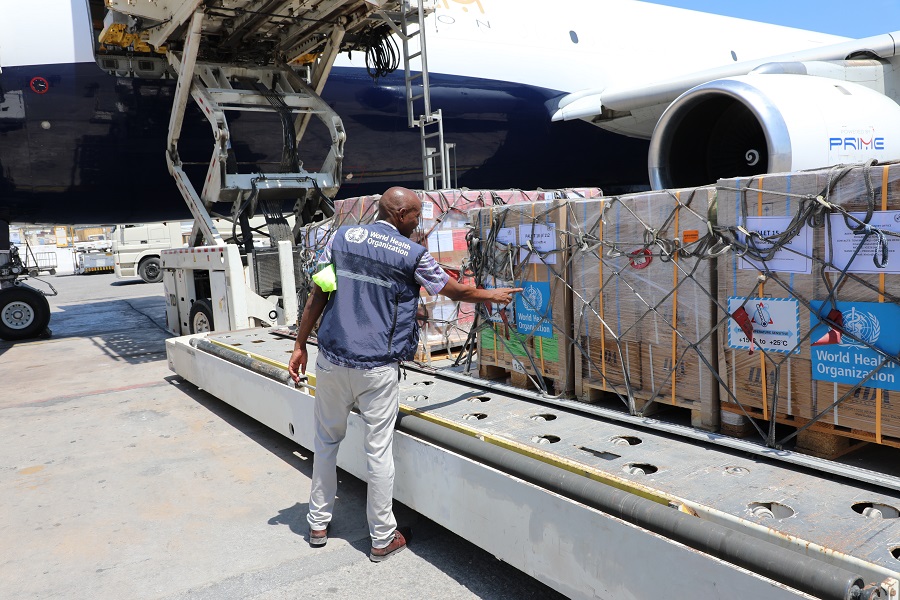 Air transportation is the major means of transportation across the country to maintain a medical supply chain across Somalia. Credit: WHO Somalia
Air transportation is the major means of transportation across the country to maintain a medical supply chain across Somalia. Credit: WHO Somalia
Mogadishu, 2 April 2023 – To ensure sustained and reliable health services in an extremely challenging environment, WHO has used innovation and creativity to help the Federal and State ministries of health establish an operational medical supply chain for serving the most vulnerable and disadvantaged populations across the country.
WHO has managed to airlift, transport and stock over 1400 tonnes of medical commodities, worth around US$ 5 million during the past year to support essential health and nutrition care to the vulnerable population in the midst of extreme drought and food insecurity, which the country has been facing since November 2021. These supplies have been instrumental in providing basic health care and patient consultations to about 3.6 million people in the marginalized communities, protecting about 3.5 million children under 5 in access-constrained areas against various childhood diseases like polio, measles, cholera, malnutrition and helped administer various micronutrient supplements like vitamin A and deworming tablets to another one million children under 5.
To keep the medical stocks handy to meet the emergency needs of the country, especially in the face of an ongoing pandemic and drought, WHO is maintaining contingent stocks in 3 strategically located warehouses in Mogadishu (2553 cubic metres), Hargeisa (1540 cubic metres) and Garowe (536 cubic metres). To bring services closer to the people, WHO is in the process of opening 3 additional warehouses in the cities of Dollow, Kismaiyo, and Baidoa to better serve the states of Jubaland and South West--most affected by the drought, cholera outbreaks and internally displaced persons (IDPs). While WHO continues to strengthen the health systems and improve access to health care for the people caught in the cycle of conflict and climatic shock, such as the drought in hard-to-reach areas, the Organization is supporting the Government to establish a strong supply chain system, which will be pivotal for sustainable and equitable recovery of the health system from the convergence of crisis the country is facing. At the same time, a strong and operationally functioning supply chain system will contribute to building resilience for achieving universal health coverage. To this end, WHO continues to ensure improved access to health care for the vulnerable populations through delivery of medical supplies close to the communities using its humanitarian response imperatives. It also works towards building a system that supports availability and equitable delivery and distribution of medicine/product at the right time, minimizing inventory wastage, maximizing patient care and coordinating with other parts of the chain to ensure that health care providers and health care seekers get the medications and treatments they need and where they need them.
“Being a health professional and working in a resource-starved and geographically challenged health system in a conflict zone, WHO supplies are proving to be a lifeline for millions. Everyone wondered how a medical supply chain could work in Somalia, but I believe WHO has shown it to the world that if there is a resolve to serve humanity, obstacles can be turned into opportunities,” commented Dr Yusuf Omar Mohamed, Head of Pharmaceuticals & Supply Chain Section, Ministry of Health and Human Services, Federal Government of Somalia, while reflecting on WHO’s contribution is establishing the supply chain.
Medical supplies procured and delivered by WHO include kits for testing inter emergency health, trauma care, malaria, tuberculosis, HIV-AIDs, cholera and measles besides having medicines for treatment of all these diseases, as well as personal protective equipment (PPEs), long lasting insecticidal nets to control malaria, oxygen concentrators, solar panels, electricity generators, and ambulances among others public health, IT and office materials.
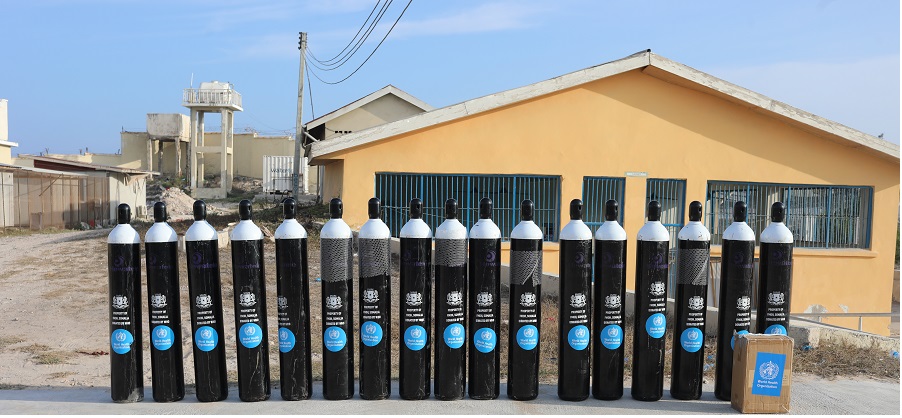 Oxygen cylinders procured and delivered to remote health facility in Galmudug. Credit: WHO/Somalia
Oxygen cylinders procured and delivered to remote health facility in Galmudug. Credit: WHO/Somalia
Supply chain system
Due to security reasons and other operational challenges, WHO uses the seaports of both Somalia and neighbouring countries to import the majority of the required medical supplies. Procurement of medical supplies is triggered by programme staff via consultation with Health Cluster partners and the Federal and State ministries of health. The programme staff also develop a distribution plan to reach the health facilities at state, regional and district level to ensure procurements are accounted for and reach the target beneficiaries.
A transparent and layered procurement system then swings into action to seek the best and suitable supplies from across the global suppliers within established timelines. A regular procurement may take up to 3 months but in case of emergencies like the October 2022 twin-blasts in Mogadishu, WHO expedited the process and within a week after the blast airlifted trauma kits worth over US$ 1 million from the International Humanitarian City in Dubai.
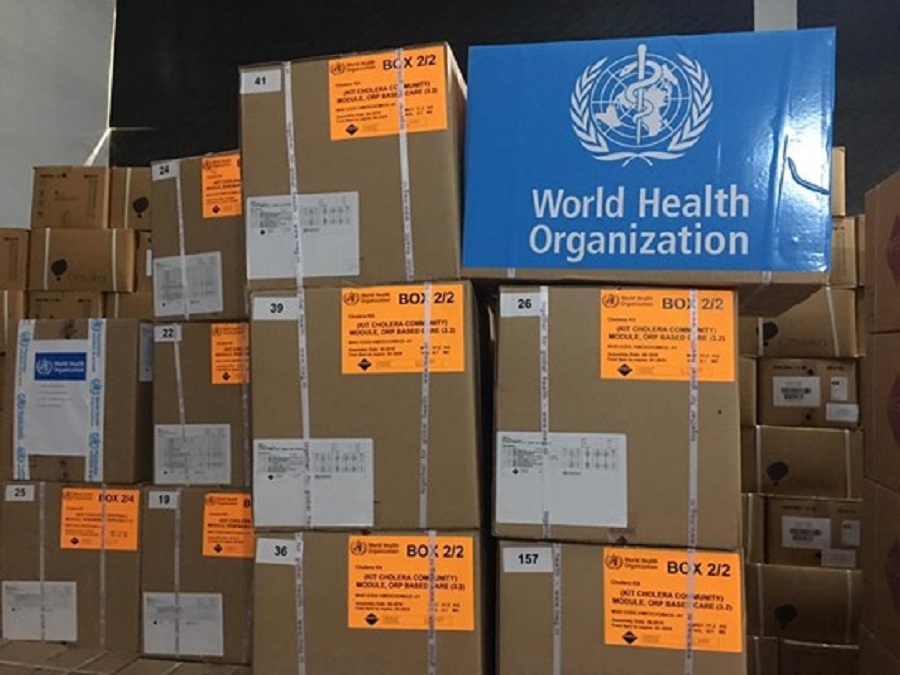 Maintaining inventory of essential medical supplies throughout the year helped serve and save millions. Credit: WHO/Somalia
Maintaining inventory of essential medical supplies throughout the year helped serve and save millions. Credit: WHO/Somalia
Distribution network
When medical supplies arrive in the WHO main warehouse in Mogadishu, they are either distributed directly to the districts from Mogadishu as per the agreed distribution plan, or sent to the designated states for storage and dissemination to the health facilities. Currently, the warehouse in Garowe is serving Puntland State while Hargeisa is serving Somaliland and the rest of the states are served directly from the main WHO warehouse in Mogadishu.
Due to the security situation in the country, there is limited use of road transport, hence the majority of the medical supplies are moved by air from Mogadishu to the state warehouses where they are received by the state ministries of health for further distribution to the public health facilities.
“What satisfies us is the fact that people express gratitude to WHO for bringing these critical medical supplies. It indeed is a big motivational factor for us to brave all the odds and maintain a steady stream of life-saving supplies,” said Operations Support and Logistics Officer for WHO Somalia, Harrison Kiambuthi. “In the process of doing our work,” he added that, “We are also building local capacities in this comparatively new concept of medical supply chain management to ensure sustainability of our efforts besides continuing to bring digitization of the warehouse stocks and its air and road movement.”
WHO Somalia is grateful for the benevolence of donors like European Civil Protection and Humanitarian Aid Office (ECHO), World Bank and our trusted fund streams like Central Emergency Response Fund (CERF) and Contingency Fund for Emergency (CFE) for making this dream come true. These partners have helped WHO to ensure sustained provision of health services through 7 public health laboratories, 64 nutrition stabilization centres, 13 cholera treatment centres, 10 oral rehydration centres, 281 health facilities and numerous outreach teams including over 2000 community health workers.
Related links
New study finds that 43 000 “excess deaths” may have occurred in 2022 from the drought in Somalia
Half of the drought-related deaths occurred among children under the age of 5
Mogadishu, 20 March 2023 – A new report released today by the Federal Ministry of Health & Human Services, WHO and UNICEF suggests that an estimated 43 000 excess deaths may have occurred in 2022 in Somalia due to the deepening drought, a figure higher than that of the first year of the 2017–2018 drought crisis. Half of these deaths may have occurred among children under the age of 5.
The findings of the report were released today by the Minister of Health of the Federal Government of Somalia, Dr Ali Hadji Adam Abubakar, in the presence of Mr Adam Abdelmoula, Deputy Special Representative of the Secretary-General and United Nations Resident and Humanitarian Coordinator for Somalia, Ms Wafaa Saeed, UNICEF Country Representative of Somalia and Dr Sk Md Mamunur Rahman Malik, WHO Representative for Somalia.
For the first time, a scenario-based forecast model was developed from the same study to enable anticipatory action and avert drought-related deaths. The forecast, spanning January to June 2023, estimates that 135 people might also die each day due to the crisis, with total deaths projected to fall between 18 100 and 34 200 during this period. These estimates suggest that, although famine has been averted for now, the crisis is far from over and is already more severe than the 20172018 drought crisis.
These figures are derived from a statistical model which estimated that the crude death rate increased across Somalia from 0.33 to 0.38 deaths per 10 000 person-days over the period January–December 2022; the rate in children younger than 5 years was nearly double these levels. For 2023, the crude death rate is forecasted to reach 0.42 deaths per 10 000 person-days by June 2023.
Commissioned by the UNICEF Regional Office and WHO Somalia country office and carried out by the London School of Hygiene and Tropical Medicine and Imperial College London, the study presents retrospective estimates of mortality across Somalia from January to December 2022. The highest death rates were estimated to have occurred in south-central Somalia, especially the areas around Bay, Bakool and Banadir regions, the current epicentre of the drought.
The study, the first in a planned series, received support from the Federal Ministry of Health & Human Services of the Federal Government of Somalia and the Food Security and Nutrition Analysis Unit of the Food and Agriculture Organization of the United Nations, and was funded by the Foreign, Commonwealth & Development Office of the United Kingdom.
While releasing the findings of the report, Minister Dr Ali Hadji Adam Abubakar commented:
“We continue to be concerned about the level and scale of the public health impact of this deepening and protracted food crisis in Somalia. At the same time, we are optimistic that if we can sustain our ongoing and scaled-up health and nutrition actions and humanitarian response to save lives and protect the health of our vulnerable, we can push back the risk of famine forever, else those vulnerable and marginalized will pay the price of this crisis with their lives. We, therefore, urge all our partners and donors to continue to support the health sector in building a resilient health system that works for everyone and not for the few. Building a healthier and happier world for all Somalis remains at the heart of our government.”
WHO Representative Dr Mamunur Rahman Malik, commenting on the study findings, said that:
“We are racing against time to prevent deaths and save lives that are avoidable. We have seen, deaths and diseases thrive when hunger and food crises prolong. We will see more people dying from disease than from hunger and malnutrition combined if we do not act now. The cost of our inaction will mean that children, women and other vulnerable people will pay with their lives while we hopelessly, helplessly, witness the tragedy unfold.”
Dr Malik added that:
“From the very beginning of this drought, WHO has clearly stated that the drought is a health crisis as much as it is a food and climate crisis. WHO’s main concern has been to prevent excess deaths directly or indirectly attributed to drought with a special focus on women and children under 5. As such, WHO has stepped up its life-saving integrated health interventions throughout 2022 and would continue to do so in 2023 to avert every preventable death in Somalia.”
“These results present a grim picture of the devastation brought on children and their families by the drought,” said UNICEF Representative Wafaa Saeed.
“We are saddened by these deaths, and we know there could have been many more deaths had humanitarian assistance not been scaled up to reach affected communities. We must continue to save lives by preventing and treating malnutrition, providing safe and clean water, improving access to life-saving health services, immunizing children against deadly diseases such as measles and providing critical protection services.”
Somalia is enduring five consecutive seasons of failed rains, the longest in recent memory, which has left 5 million people in acute food insecurity and nearly 2 million children at risk of malnutrition. The United Nations needs more than US$ 2.6 billion to meet the priority needs of 7.6 million people in 2023.
Note to Editors:
The current drought crisis in Somalia is unfolding against an already grim backdrop. With nearly half of the population (7.9 million) in need of humanitarian assistance, the situation is exacerbated by climate change-induced extreme weather, political instability, ethnic tensions and insecurity, which continue to worsen public health and nutrition concerns. Six consecutive failed rainy seasons have caused the drought, which coincides with rapidly increasing global food prices, intensification of insecurity in some regions and the socioeconomic aftermath of the COVID-19 pandemic. As with previous complex crises, it has been accompanied by large movements of internally displaced persons (IDPs) (3.5 million recorded by humanitarian actors). In the context of this latest crisis, the London School of Hygiene and Tropical Medicine was commissioned by WHO and UNICEF to produce both retrospective and forecasting estimates of overall and crisis-attributable excess mortality across Somalia and suggest action points.
A summary of the report can be downloaded here.
For additional information, please contact:
Ministry of Health and Human Services, Federal Republic of Somalia:
UNICEF
Victor Chinyama
+252 613 375 885
WHO:
Fouzia Bano
Kyle De Freitas
